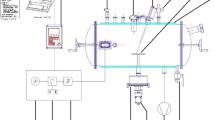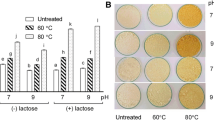Abstract
Microwave vacuum drying (MWVD) of lactic acid bacteria is a promising alternative to conventional drying techniques. To further optimize this process and inhibit diffusion-limiting shrinkage in the last drying period, it was attempted to embed bacteria into a protective aerated matrix. As a foaming agent, whey protein isolate (WPI) was used. Besides, different carbohydrates (i.e., maltose (M), maltodextrin (MD), and sorbitol (S)) were evaluated for their ability to maintain structural stability as well as for their suitability as protectant during MWVD. Foam properties at atmospheric pressure as a function of carbohydrate type and concentration, WPI concentration and concentration of the model strain Lactobacillus paracasei ssp. paracasei F19 (L. paracasei) were related to MWVD behavior and product quality (e.g., survival rate). Therewith, it was aimed at specifying crucial characteristics as well as guiding values regarding foam design intended for MWVD. Overall, high foam stability combined with small and homogeneously distributed bubbles was defined as prerequisite. Further, M- and MD-based foams, in contrast to S-containing matrices, were effectively dried without foam collapse. The best drying performance regarding drying time, microwave energy demand, and survival rate was achieved with MD-stabilized foams. Besides, the general benefit of foam drying as well as the protective effect of MD during MWVD was demonstrated. By comparing MD-stabilized foams to non-foamed MD-containing suspensions as well as pure L. paracasei, the shortest drying time and highest survival rates resulted for the aerated matrices. Concluding, microwave vacuum foam drying displays an innovative approach for the preservation of lactic acid bacteria.






Similar content being viewed by others
References
Abdul-Fattah, A. M., Truong-Le, V., Yee, L., Pan, E., Ao, Y., Kalonia, D. S., et al. (2007). Drying-induced variations in physico-chemical properties of amorphous pharmaceuticals and their impact on stability II: stability of a vaccine. Pharmaceutical Research, 24(4), 715–727.
Ahmad, S., Yaghmaee, P., & Durance, T. (2012). Optimization of dehydration of Lactobacillus salivarius using radiant energy vacuum. Food and Bioprocess Technology, 5(3), 1019–1027.
Ambros, S., Bauer, S. A. W., Shylkina, L., Foerst, P., & Kulozik, U. (2016). Microwave-vacuum drying of lactic acid bacteria: influence of process parameters on survival and acidification activity. Food and Bioprocess Technology, 9(11), 1901–1911.
Ambros, S., Dombrowski, J., Boettger, D., & Kulozik, U. (2018a). The concept of microwave foam drying under vacuum: a gentle preservation method for sensitive biological material. Journal of Food Science, under review.
Ambros, S., Foerst, P., & Kulozik, U. (2018b). Temperature-controlled microwave-vacuum drying of lactic acid bacteria: impact of drying conditions on process and product characteristics. Journal of Food Engineering, 224, 80–87.
Ambros, S., Hofer, F., & Kulozik, U. (2018c). Protective effect of sugars on storage stability of microwave freeze-dried and freeze-dried Lactobacillus paracasei F19. Journal of Applied Microbiology, 125(4), 1128–1136.
Avaltroni, F., Bouquerand, P. E., & Normand, V. (2004). Maltodextrin molecular weight distribution influence on the glass transition temperature and viscosity in aqueous solutions. Carbohydrate Polymers, 58(3), 323–334.
Bals, A., & Kulozik, U. (2003a). Effect of pre-heating on the foaming properties of whey protein isolate using a membrane foaming apparatus. International Dairy Journal, 13(11), 903–908.
Bals, A., & Kulozik, U. (2003b). The influence of the pore size, the foaming temperature and the viscosity of the continuous phase on the properties of foams produced by membrane foaming. Journal of Membrane Science, 220(1), 5–11.
Bauer, S. A. W., Schneider, S., Behr, J., Kulozik, U., & Foerst, P. (2012). Combined influence of fermentation and drying conditions on survival and metabolic activity of starter and probiotic cultures after low-temperature vacuum drying. Biotechnology for enhancing plant production and food quality - IBS 2010 Part III, 159(4), 351–357.
Berry, R. E., Bissett, O. W., Wagner, C. J., & Veldhuis, M. K. (1965). Method for evaluating foams from citrus concentrates. Food Technology, 19(5), 144–147.
Brygidyr, A. M., Rzepecka, M. A., & McConnell, M. B. (1977). Characterization and drying of tomato paste foam by hot air and microwave energy. Canadian Institute of Food Science and Technology Journal, 10(4), 313–319.
Campbell, G. M., & Mougeot, E. (1999). Creation and characterisation of aerated food products. Trends in Food Science & Technology, 10(9), 283–296.
Chanasattru, W., Decker, E. A., & McClements, D. J. (2008). Impact of cosolvents (polyols) on globular protein functionality: ultrasonic velocity, density, surface tension and solubility study. Food Hydrocolloids, 22, 1475–1484.
Cooke, R. D., Breag, G. R., Ferber, C. E. M., Best, P. R., & Jones, J. (1976). Studies of mango processing. International Journal of Food Science and Technology, 11(5), 463–473.
Dickinson, E. (1998). Stability and rheological implications of electrostatic milk protein-polysaccharide interactions. Trends in Food Science & Technology, 9, 347–354.
Dombrowski, J., Dechau, J., & Kulozik, U. (2016a). Multiscale approach to characterize bulk, surface and foaming behavior of casein micelles as a function of alkalinisation. Food Hydrocolloids, 57, 92–102.
Dombrowski, J., Mattejat, C., & Kulozik, U. (2016b). Correlation between surface activity and foaming properties of individual milk proteins in dependence of solvent composition. International Dairy Journal, 61, 166–175.
Foerst, P., & Kulozik, U. (2012). Modelling the dynamic inactivation of the probiotic bacterium L. paracasei ssp. paracasei during a low-temperature drying process based on stationary data in concentrated systems. Food and Bioprocess Technology, 5(6), 2419–2427.
Foerst, P., Reitmaier, J., & Kulozik, U. (2010). 1H NMR investigation on the role of sorbitol for the survival of Lactobacillus paracasei ssp. paracasei in vacuum-dried preparations. Journal of Applied Microbiology, 108, 841–850.
Foerst, P., Kulozik, U., Schmitt, M., Bauer, S., & Santivarangkna, C. (2012). Storage stability of vacuum-dried probiotic bacterium Lactobacillus paracasei F19. Food and Bioproducts Processing, 90(2), 295–300.
Hajare, A., More, H., & Pisal, S. (2011). Effect of sugar additives on stability of human serum albumin during vacuum foam drying and storage. Current Drug Delivery, 8(6), 678–690.
Hanselmann, W., & Windhab, E. (1999). Flow characteristics and modelling of foam generation in a continuous rotor/stator mixer. Journal of Food Engineering, 38, 393–405.
Hardy, Z., & Jideani, V. A. (2017). Foam-mat drying technology: a review. Critical Reviews in Food Science and Nutrition, 57(12), 2560–2572.
Kim, S. S., Shin, S. G., Chang, K. S., Kim, S. Y., Noh, B. S., & Bhowmik, S. R. (1997). Survival of lactic acid bacteria during microwave vacuum-drying of plain yoghurt. LWT - Food Science and Technology, 30(6), 573–577.
Koster, K. L., Maddocks, K. J., & Bryant, G. (2003). Exclusion of maltodextrins from phosphatidylcholine multilayers during dehydration: effects on membrane phase behaviour. European Biophysics Journal, 32(2), 96–105.
Krasaekoopt, W., & Bhatia, S. (2012). Production of yoghurt powder using foam-mat drying. AU Journal of Technology, 15(3), 166–168.
Kreuß, M., Krause, I., & Kulozik, U. (2009). Influence of glycosylation on foaming properties of bovine caseinomacropeptide. International Dairy Journal, 19(12), 715–720.
Kudra, T., & Ratti, C. (2006). Foam-mat drying: energy and cost anylyses. Canadian Biosystems Engineering, 48(3), 3.27–3.32.
Lobo, F. A., Nascimento, M. A., Domingues, J. R., Falcão, D. Q., Hernanz, D., Heredia, F. J., et al. (2017). Foam mat drying of Tommy Atkins mango: effects of air temperature and concentrations of soy lecithin and carboxymethylcellulose on phenolic composition, mangiferin, and antioxidant capacity. Food Chemistry, 221, 258–266.
Marinova, K. G., Basheva, E. S., Nenova, B., Temelska, M., Mirarefi, A. Y., Campbell, B., et al. (2009). Physico-chemical factors controlling the foamability and foam stability of milk proteins: sodium caseinate and whey protein concentrates. Food Hydrocolloids, 23(7), 1864–1876.
Ohtake, S., Martin, R., Saxena, A., Pham, B., Chiueh, G., Osorio, M., et al. (2011). Room temperature stabilization of oral, live attenuated Salmonella enterica serovar Typhi-vectored vaccines. Vaccine, 29(15), 2761–2771.
Oldenhof, H., Wolkers, W. F., Fonseca, F., Passot, S., & Marin, M. (2008). Effect of sucrose and maltodextrin on the physical properties and survival of air-dried Lactobacillus bulgaricus: an in situ Fourier transform infrared spectroscopy study. Biotechnology Progress, 21(3), 885–892.
Phillips, G. L., Schulman, W., & Kinsella, E. J. (1990). pH and heat treatment effects on foaming of whey protein isolate. Journal of Food Science, 55(4), 1116–1119.
Qadri, O. S., & Srivastava, A. K. (2015). Microwave-assisted foam mat drying of guava pulp: drying kinetics and effect on quality attributes. Journal of Food Process Engineering, 40(1), 1–8.
Qiang, L., Yu, S., Xiang-wen, X., Qin-qin, Z., & Xian-zhe, Z. (2013). Drying characteristics of microwave-assisted foam drying of corn soaking water. Journal of Northeast Agricultural University, 20(1), 53–59.
Rajkumar, P., Kailappan, R., Viswanathan, R., & Raghavan, G. S. V. (2007). Drying characteristics of foamed alphonso mango pulp in a continuous type foam mat dryer. Journal of Food Engineering, 79(4), 1452–1459.
Ratti, C., & Kudra, T. (2006). Drying of foamed biological materials: opportunities and challenges. Drying Technology, 24(9), 1101–1108.
Roos, Y. (1993). Melting and glass transitions of low molecular weight carbohydrates. Carbohydrate Research, 238, 39–48.
Salahi, M. R., Mohebbi, M., & Taghizadeh, M. (2014). Foam-mat drying of cantaloupe (Cucumis melo): optimization of foaming parameters and investigating drying characteristics. Journal of Food Processing and Preservation, 39(6), 1798–1808.
Sangamithra, A., Sivakumar, V., Swamy, G. J., & Kannan, K. (2014). Foam mat drying of food materials: a review. Journal of Food Processing and Preservation, 39(6), 3165–3174.
Sankat, C. K., & Castaigne, F. (2004). Foaming and drying behaviour of ripe bananas. Lebensmittel-Wissenschaft und -Technologie, 37, 517–525.
Santivarangkna, C., Higl, B., & Foerst, P. (2008). Protection mechanisms of sugars during different stages of preparation process of dried lactic acid starter cultures. Food Microbiology, 25(3), 429–441.
Santivarangkna, C., Kulozik, U., Kienberger, H., & Foerst, P. (2009). Changes in membrane fatty acids of Lactobacillus helveticus during vacuum drying with sorbitol. Letters in Applied Microbiology, 49(4), 516–521.
Séguineau de Préval, E., Ducept, F., Cuvelier, G., & Mezdour, S. (2014). Effect of bulk viscosity and surface tension kinetics on structure of foam generated at the pilot scale. Food Hydrocolloids, 34, 104–111.
Sprunk, A., Page, S., & Kleinebudde, P. (2013). Influence of process parameters and equipment on dry foam formulation properties using indomethacin as model drug. International Journal of Pharmaceutics, 455(1), 189–196.
Timasheff, S. N. (2002). Protein-solvent preferential interactions, protein hydration, and the modulation of biochemical reactions by solvent components. PNAS, 99(15), 9721–9726.
Venkatesh, M. S., & Raghavan, G. S. V. (2004). An overview of microwave processing and dielectric properties of agri-food materials. Biosystems Engineering, 88(1), 1–18.
Yaghmaee, P., & Durance, T. D. (2002). Predictive equations for dielectric properties of NaCl, D-sorbitol and sucrose solutions and surimi at 2450 MHz. Journal of Food Science, 67(6), 2207–2211.
Zheng, X.-Z., Liu, C.-H., & Zhou, H. (2011). Optimization of parameters for microwave-assisted foam mat drying of blackcurrant pulp. Drying Technology, 29(2), 230–238.
Acknowledgments
This IGF Project of the FEI was supported via AiF (AiF 17477 N) within the program for promoting the Industrial Collective Research (IGF) of the German Ministry of Economic Affairs and Energy (BMWi), based on a resolution of the German Parliament. The authors would like to thank Chr. Hansen Inc. (Hørsholm, Denmark) for the kind providing of L. paracasei cultures.
Author information
Authors and Affiliations
Corresponding author
Additional information
Publisher’s Note
Springer Nature remains neutral with regard to jurisdictional claims in published maps and institutional affiliations.
Sabine Ambros and Jannika Dombrowski shared first authorship.
Rights and permissions
About this article
Cite this article
Ambros, S., Dombrowski, J., Boettger, D. et al. Structure-Function-Process Relationship for Microwave Vacuum Drying of Lactic Acid Bacteria in Aerated Matrices. Food Bioprocess Technol 12, 395–408 (2019). https://doi.org/10.1007/s11947-018-2218-y
Received:
Accepted:
Published:
Issue Date:
DOI: https://doi.org/10.1007/s11947-018-2218-y




